Crowle Market Place - Pictures and
words by Bill Goldthorp
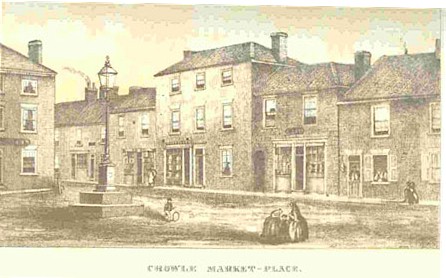
The market square has barely changed in
over one and a half centuries. The above sketch, from the mid
1850ís, is taken from Readís History of the Isle of Axholme
published in 1858.
Note the gas
lamp, the only streetlight in Crowle. Crowle was modern; it had a
gas works, which paid good dividends to its investors. The gas works
lasted to about 1940 when it went bust. We were now old fashioned;
all the street lamps were gas. The blackout finished off the gas
works. Unfortunately early 1939 Crowle Council took out a contract
with the gas works for street lighting until 1950.
When the war
ended the street blackout continued in Crowle. Electric street lights
could not be put in until the contract ended in 1950. Film
certification did begin until later. U anyone, A under 16 must be
accompanied by an adult, X 18 and over.
I was quite
happy to return from the Regal after watching Boris Karloff in the
Mummy or Frankenstein, Bela Lugosi in Dracula; I cannot remember the
Werewolves star. The lads would drop of one by one, but Len Slingby
and I lived next door to each other at 42 and 44, it was only poor
Chippy Chapman who would plead for our company as far as number 60.
Invariably refused, Chippy would leg it the next 100 yards. The
Olympic Selection Committee should have been there, we reckoned that
Chippy could do that 100 yards in 5 seconds flat.
Two pals
Laurence Lowthorpe and Mike Maw who live at Tetley never joined us
in these excursions, they had another 200 yards along Wharf Road and
then 250 along the drive to Tetley hall, dark and dingy, lined with
ancient 200 year old elms and other trees, home to several species
of owls, who hooted away in the most scary manner.
In addition at
the top of the drive were several graves of the Stovin family, who
once had a row with the local vicar. The Stovins were said to have
come over as archers with William the Bastard. The latter being a
far better term than Conqueror, being both true as regards to
legitimacy and behaviour. The Stovins still exist as a very
prosperous family in various parts of the United States, where they
have substantial properties by the name of Tetley, Tetley House,
Tetley Hall, Totlets etc..
Williamís mother
was a tannerís daughter, far sturdier and healthier than his
fatherís official wife; she produced a string of healthy violent
offspring, of which William was one. Recognising an asset when he
had on, Roger the Vicious, or something similar, Duke of Normandy
made William his heir. The other was his ďHarrying of the NorthĒ
when they objected to him taking the throne. The locals disappeared
into the forest when his soldiers appeared, so the soldiers
destroyed all the crops and livestock. The following winter
starvation did what his soldiers could not.
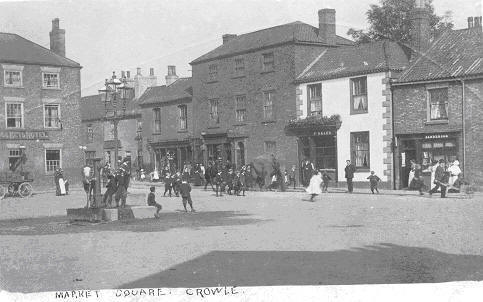
Taken in 1908.
Now there are three gas lamps in the
square and all the streets were lit. Those three lamps enable me to
assess the date of other photographs. All the unoccupied lads must have turned up
to water the elephant, there must be over thirty. I wonder how many
were still alive in 1918. Slaughtered in a war many believe could
have been avoided. If you stand in that position today, in front of
the butcherís shop that was once the Police Station. Very little has
altered, the buildings are still there, the water pump and gas lamp
have gone, but ignore the centre the view is still the same.

Again a similar date.
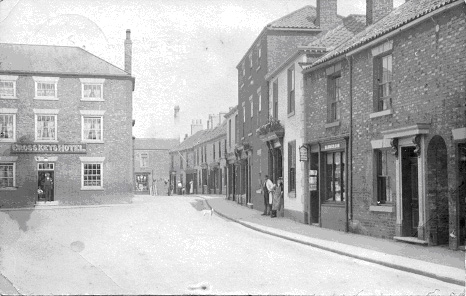
Looking north up the High Street.
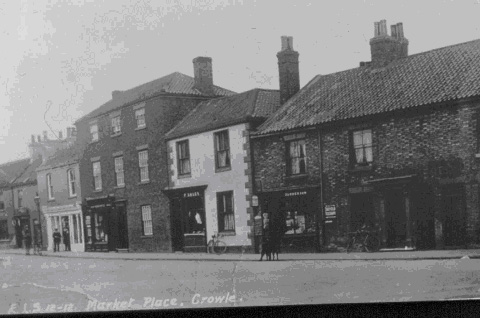
Row of shops on the east edge of the Market Place.
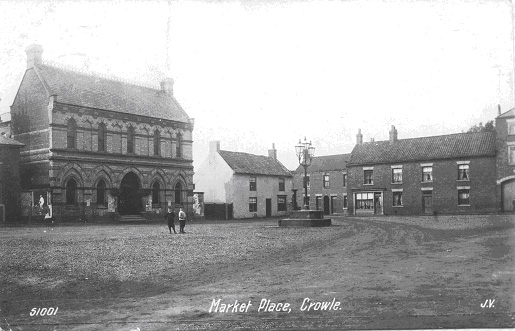
The Market Hall.
The dress of the boy on the left is similar to
the boys in the other photographs. The house and shop that were next
to the Cross Keys in the
thirties and during the war housed Dr. Dickinsonís branch surgery.
The triple gaslight is the clue and the condition of the square
itself.

Probably about
the same time. It looks like London & Yorkshire Bank on the window. The
covering of the square looks similar. There was a branch of a bank
on this corner for many years after I went to university. One of the
many errands I was sent on to do on my own when still at school was
taking the cheques and cash to the bank to be paid into my fatherís
account. It is surprising what I was trusted with from about the age
of 9 onwards.

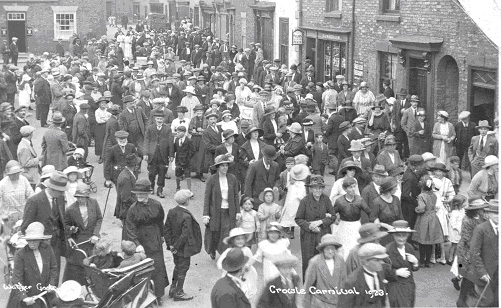
Two
photographs of the Crowle Carnival in 1923.
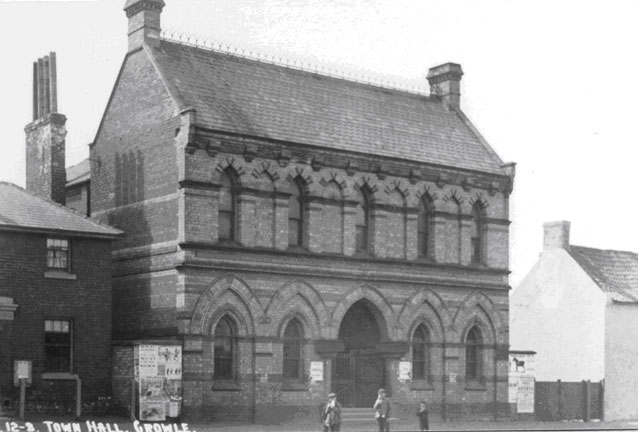
Probably the early 1920s. It looks like a
police notice outside the police station. There are only a few
notices on the town hall not the large ones advertising films that
the elder Mr. Spivey put up when he arrived in Crowle around 1930 in
order to use the hall as cinema. I have vague memories of my father
taking me to see a film there, terribly frightened as figures
flickered on a white screen with a piano playing in the background.
The trip was a failure. Daddy had to take his little boy home.
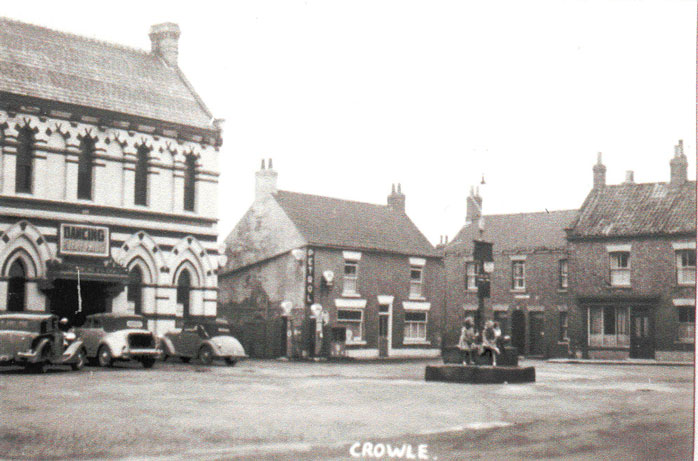
Early 1950's.
A Morris Minor and the street
light is electric. We had no street lighting for five years after
the war ended. Note the petrol pumps. In the mid to late fifties
television began to ruin the small cinemas. The Regal became a Bingo
hall and Bill Spivey left his house on Wharf Road, living in the
corner house selling petrol and spare parts for cars.
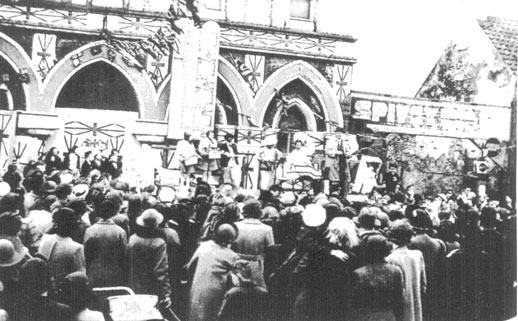
War Weapons Week
photograph, 1941 or 1942, taken by Mr. Spivey senior,
part of a moving picture reel.
War Weapons Week, occurred the same week as Crowle
Fair and Gymkhana.
Pinky Green the Council School headmaster was
announcing the winners of a fancy dress competitions.
The Spivey bros were Bill and Dick Spivey, Mr. Spivey
Senior's sons.
|